Architecture + Public Art

Westbank Significant Architectural Works
Westbank is dedicated to the creation of beauty, in all forms and in the broadest definition. As we have grown, the category of a developer has become too narrow to contain the essence of our practice. We are not motivated by the same things as a developer, our values are different: we invite collaborations with cultural pioneers, showcasing their work and allowing it to inform and influence our projects. We strive to develop relationships with creatives so that we function as patrons of their art, rather than as consumers of artistic services. We embrace our eclectic nature, broadening our interests and seeking out willing collaborators in art, culture, music, fashion, technology, sustainability, and architecture, while taking on projects at every scale, from the micro to the macro level. We are and have always been a practice seeking to make meaningful contributions to the cities in which we work and we see the creation of beauty as the means to this end. Through these and other endeavors, we have come to realize that, too often, beauty is mistaken as a luxury, an option or an accessory, when we have never seen it as anything less than essential. Recognizing this, we have taken it upon ourselves to fight for it: to create it, to foster it and to celebrate it. In committing our efforts fully to this end, we have evolved beyond the definition of a real estate development firm, to become a culture company.
Architectural Collaborations

Teahouse Pavilion – Kengo Kuma, Architect
One of the great pleasures of working at this level at the global scale, comes from the privilege of collaborating with some of the world’s most accomplished artists. Many of the architects with whom we work demonstrate a combination of ingenuity, originality and inspiration that would distinguish their artistry as among the best work being done in the world today. Add in the amazing artists with whom we’ve been fortunate to work with on our public art and, suffice to say, we are exceedingly grateful for these opportunities.
We have been privileged to work with architects like James Cheng, Gregory Henriquez, Bjarke Ingels, Kengo Kuma, the late Bing Thom, Venelin Kokalov, Michael Sypkens, Esteban Ochogavia, David Pontarini, Paul Merrick and Peter Busby on projects around the world. These are architects with both a breadth of vision and a talent for introspection, masters who look deeply into what they do, so they can better understand, refine and illuminate the essence of their art. With James Cheng, we have worked on numerous projects in Vancouver and Toronto that have changed the trajectory of the built environments in these cities. Today we are turning to Seattle to create First Light, a project that represents the core themes we have been exploring in our work since the beginning. With Gregory Henriquez, we began with Woodward’s to contribute to our vision for more equitable and beautiful cities and, to date, we have created over a dozen projects together, including one of our troika of initial projects at 1200 Stewart in Seattle. With Bjarke Ingels, we have created one of the most celebrated pieces of architecture in the world with Vancouver House, revolutionized Calgary’s skyline with TELUS Sky and, in Toronto, invented an evolution of Moshe Safdie’s Habitat 67 with King Street.
With Kengo Kuma, we now have five projects underway in Vancouver and Tokyo, which represent among the most refined designs we have yet achieved. We were fortunate to work with the late Bing Thom and now Revery Architects principal Venelin Kokalov on two projects in Vancouver, The Butterfly and 1684 Alberni. We have begun working with two young, talented Tokyo-based architects, Michael Sypkens and Esteban Ochogavia, whose firm, OSO, emerged out of Kengo Kuma’s office, on 400 West Georgia in Vancouver, and on The Avior, in Tokyo. With David Pontarini, we are working on 19 Duncan, in Toronto, the future home of Thomson Reuters’ Global Innovation Hub. With Paul Merrick, we are working to create a seaside community at Horseshoe Bay that embodies the West Coast Modern architectural style for which he is renowned. With Peter Busby, we are collaborating to create 707 Terry, adjacent to Seattle’s Frye Museum, and two Vancouver projects at Broadway and Commercial and Joyce Streets.
As our practice continues to grow, we continue to build relationships with architects who inspire us and push our team to grow. We hope that all our future projects are chal-lenging enough to inspire the creativity of master architects from around the world. Just as important, we hope that our projects will give us the opportunity to recognize and facilitate the emergence of new talent, as the next generation of archi-tects come into their own. We are excited to be working with talented designers like these now and look forward to future collaborations with more of the world’s great architects, designers and artists.
Artistic Collaborations

Westbank Vintage Couture Collection – Alexander McQueen, 2004
Public Art for Westbank, like so much of the work that we do, is at once a project in itself and a part of a larger idea that has woven its way through our practice over time. That idea is that our projects are not buildings, but rather they are the physical embodiment of culture. Combined, our public art commissions form a body of work that is quickly becoming one of the broad-est and most important collections created by any developer in the world. To date, we have 30 installations, either completed or underway, by some of the world’s most accomplished artists. The opportunity to work with these artists to create something that serves as both an additional layer for our buildings as well as an important cultural contribution to the city, is a gift we find deeply rewarding.
Our public art initiatives come from a desire to exemplify the successful integration of art into architecture and to use our projects as a platform for creative expression. When you think of architecture practised well, it is an art form. The public art we include is intended to complement the artistry of our buildings. They are designed to challenge, to add meaning and provoke thought in a manner that cannot be achieved solely through architecture. The end result is a project that melds creative expression with form, creating a moment of beauty, of provocation and of inspiration for the city and its inhabitants.
Since we began incorporating Public Art into our projects, we have worked with internationally renowned artists on projects whose scope, size and ambition have redefined conceptions of art in the public realm. Diana Thater’s Light Art used neon lights to mirror the colors of the surrounding natural envi-ronment in a stunning display that spans the height of Shaw Tower. Liam Gillick’s installation, lying on top of a building the clouds looked no nearer than when I was lying on the street made a provocative statement across the Fairmont Pacific Rim. Zhang Huan’s Rising created an unforgettable sculptural moment outside the Shangri-La Hotel Toronto.
As our practice has matured we have begun to commission more complex and ambitious public art work. We see public art as an opportunity not just to enhance our projects but to contribute to the culture and vibrancy of the built environment. One of our most important upcoming Public Art projects will be Rodney Graham’s Spinning Chandelier at Vancouver House. Our most recently completed piece, Martin Boyce’s lantern installation, Beyond the Sea Against the Sun illumi-nates the laneway at TELUS Garden, providing an entirely new public space and reimagining the typical laneway for the City of Vancouver.
Westbank’s commitment to public art is consistent with the many other cultural initiatives that make up our practice. Initiatives such as the Westbank Piano Program with Fazioli, ongoing exhibitions in BIG’s Serpentine Pavilion, our vintage couture collection, our partnership with Goh Ballet, our music business, the cultural hub we’re developing in Blood Alley, our support of Keys to the Street and many other programs together and alongside the effort we put into the architecture of our projects, are what sets Westbank apart.
At First Light, artist John Hogan is working alongside architect James Cheng in the production of a total work of art in Seattle, adding a further layer to what is already one of the most multi-layered projects we have yet built.
At the end of the day, we hope that each individual layer or detail of our work will stand alone as something inherently beautiful, while forming part of a larger, more complex outcome.
Graham’s sculpture extends from his 2005 35-mm film loop installation Torqued Chandelier Release in which a crystal chandelier whirls rapidly as its supporting cable is unwound. Installed under the bridge above the intersection of lower Granville Street and Beach Avenue, a monumental 14 by 21-foot crystal recreation of the film’s 18th century French chandelier will slowly rotate and rise over the course of twenty-four hours, then once a day release and dynami-cally spin back to its starting point. Spinning Chandelier will quickly become an urban icon, turning a dark under-bridge into an enjoyable focus of public celebration.
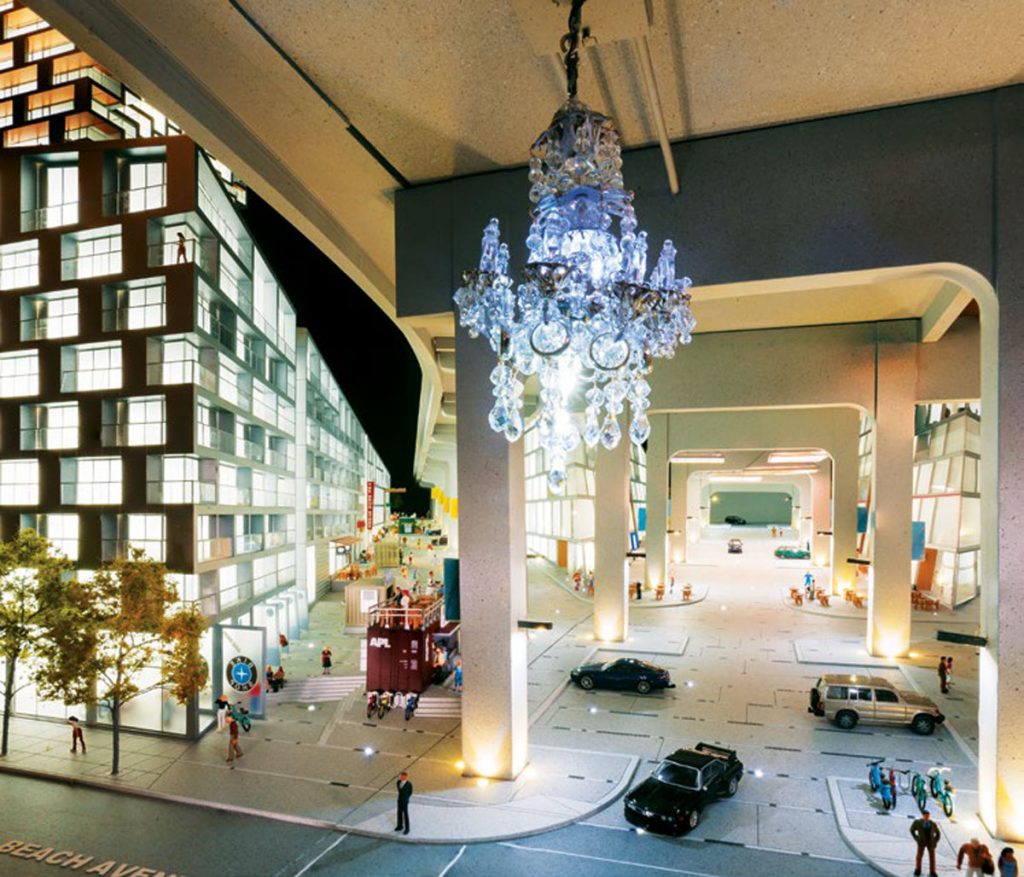
Beyond the Sea, Against the Sun, Martin Boyce’s latest installation, illuminates the laneway at TELUS Garden, inviting visitors to explore the vibrant space within. Linking three continuous chains of hanging lanterns, Boyce creates a convergence of lights at the crossroads of the laneway. Scaled up and clustered in colourful constellations, their presence will heighten the dramatic possibilities of the site while marking and activating the space below.
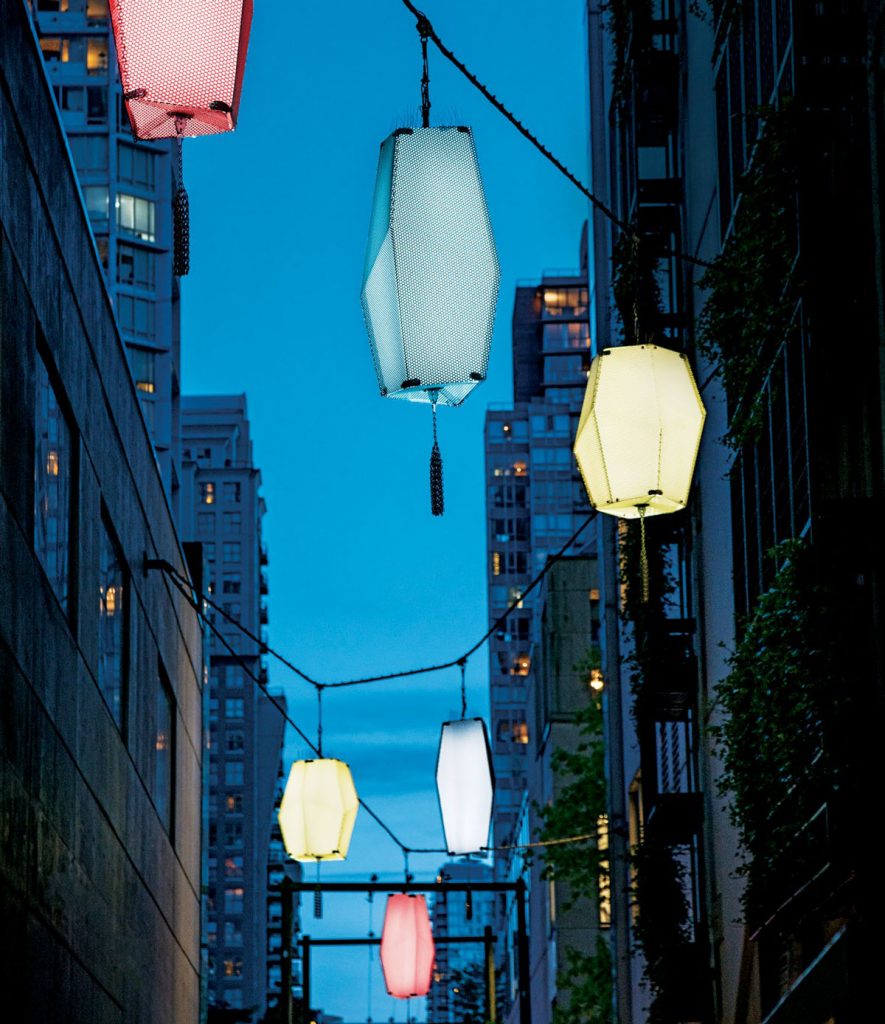
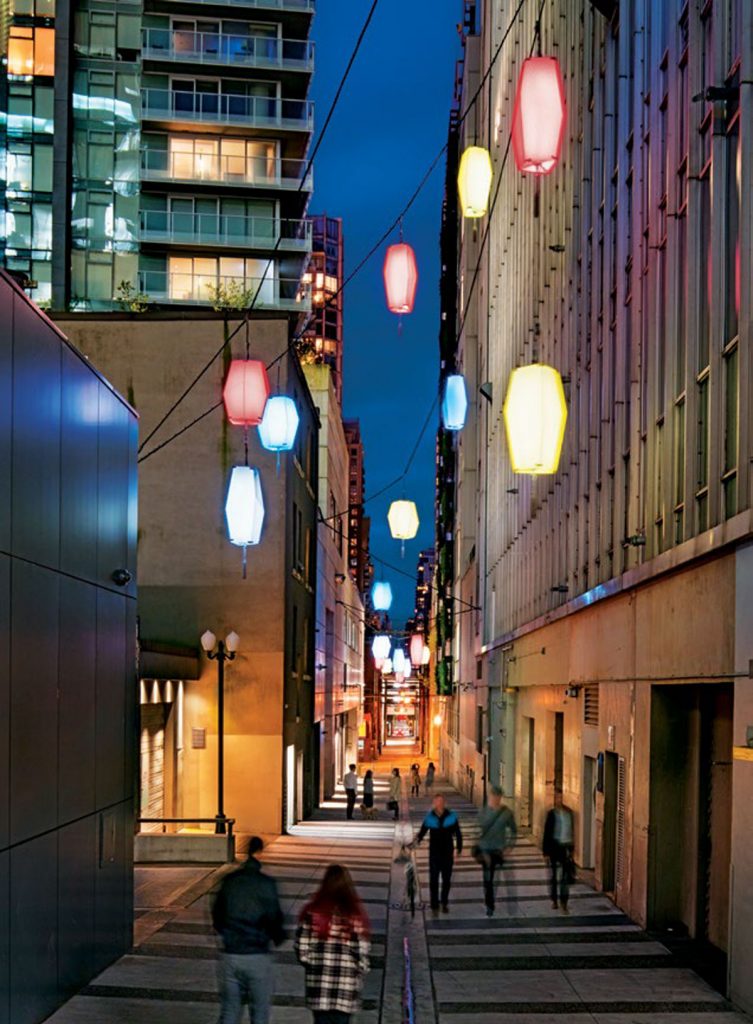
16.755 is a dramatic installation of glass “leaves” or lights supported by a set of site-specific, tree-like minarets. This abstract forest glows vibrantly at night, producing a breathtaking view for hotel visitors and passerby. The installation’s “trees” rise out of a landscape constructed of burnt wood planks and form an immersive canopy of light that reaches up to six metres in height. Bench platforms and higher mounds in the landscape serve to protect the trees from vehicles, while creating informal meeting places. Bocci numbers each of its works, and 16 was first envisioned in 2007. However, at the time, the firm lacked the technical expertise and glass knowledge to bring it to fruition. Westbank is proud to have Bocci’s very first permanent outdoor public artwork installed at the Pacific Rim hotel and in 2017, working with Bocci we added an another 355 glass leaves to the forest, to illuminate the Fight for Beauty Exhibition. Thus, 16.480 became 16.755.
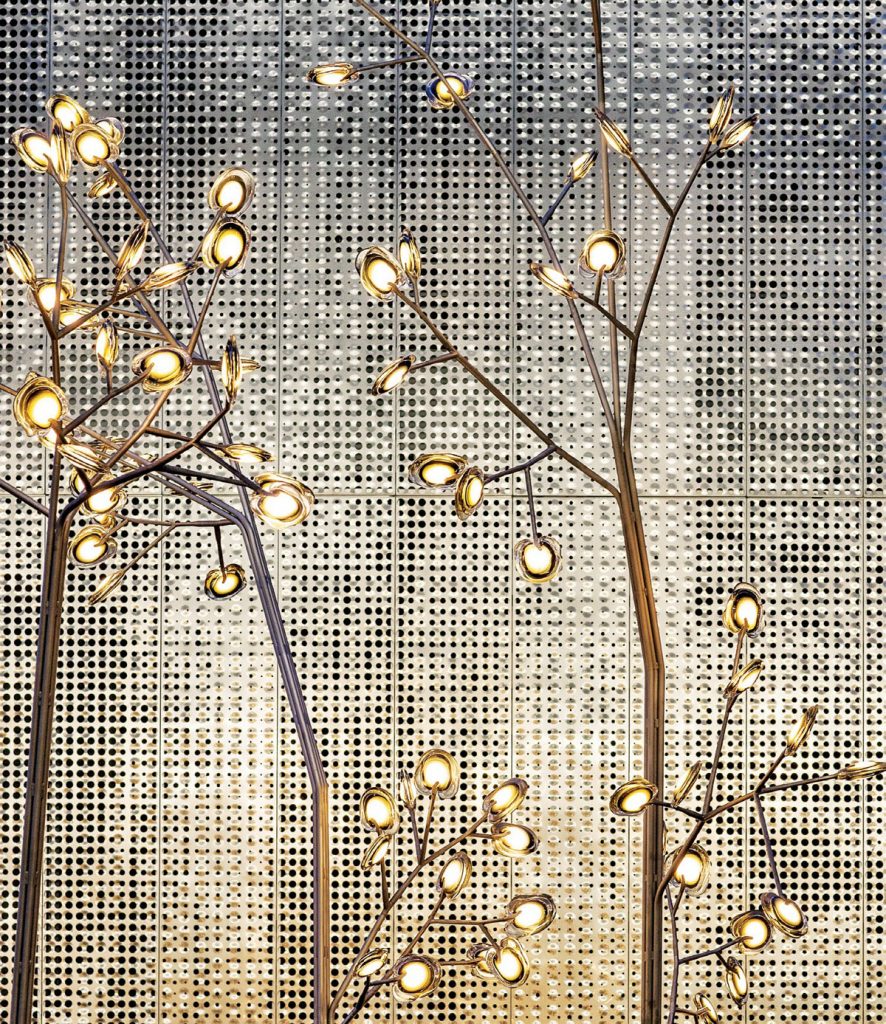

After an extensive global search conduct-ed with the Art Gallery of Ontario serving as advisor, we unanimously chose Zhang Huan, one of today’s leading contemporary artists. Captivated by the artist’s unbridled imagination, the committee felt that Huan brought a dynamic and startling creative vision to this project. While his early sculp-tural proposal depicted a flock of fluttering birds taking flight from a rooted tree trunk, he subsequently developed this motif into a series of winged birds surrounding the Shangri-La tower, appearing to animate and activate the entire façade. Each meticulous-ly fabricated bird becomes an emblem of transcendence reaching skyward. Following a visit to Toronto in 2009 and numerous discussions held in his Shanghai studio, Huan expanded his concept to include linear motifs within the main entrance spaces of Shangri-La which further extend his visual and poetic idea. This work of art has become an intrinsic part of the way people experience the architecture of Shangri-La Toronto.

A photograph of North Vancouver’s majestic rainforest, informed the perforated steel screen that graces the south western façade of the Pacific Rim Hotel. Designed by James KM Cheng, the building architect, this screen employs patented technology and comprises 9,500 square feet of stain-less steel. Through thousands of texturally rich perforations, bumps and dimples, the perforated steel creates an illusion of trees and light. Spectators may marvel at these majestic trees then step outside and experi-ence the artful transformation. Best viewed from the south side of Cordova Street.
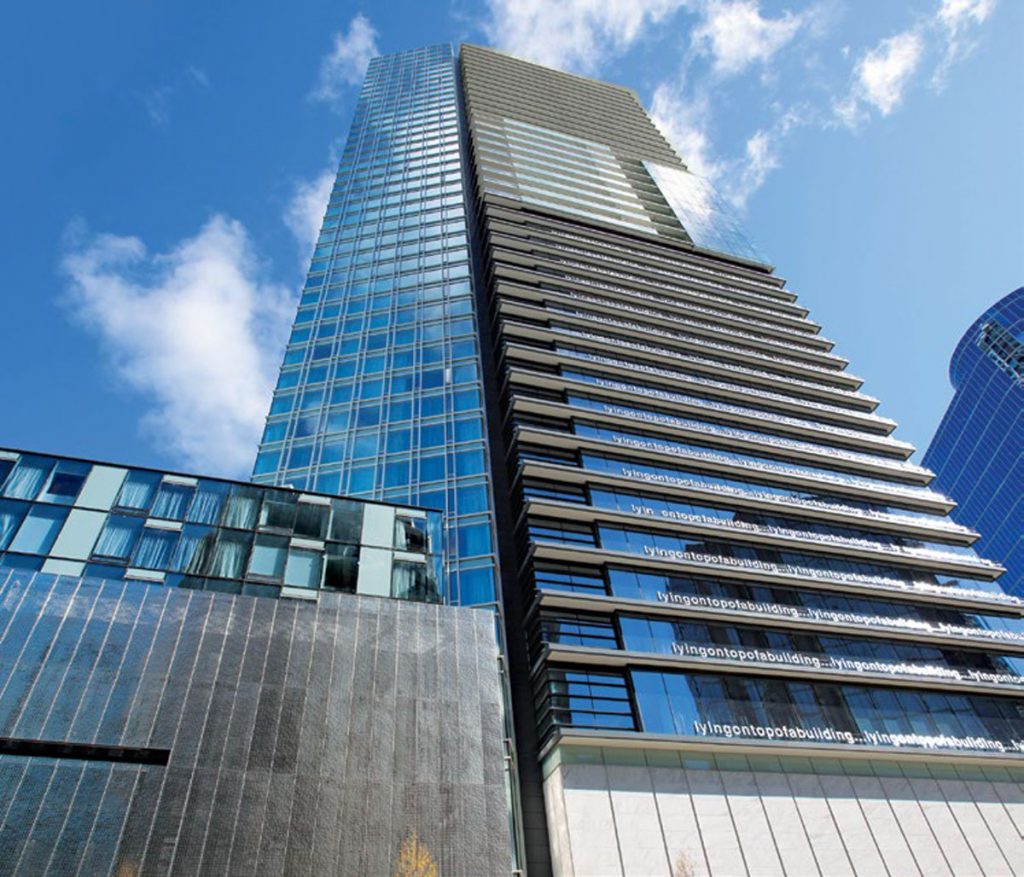
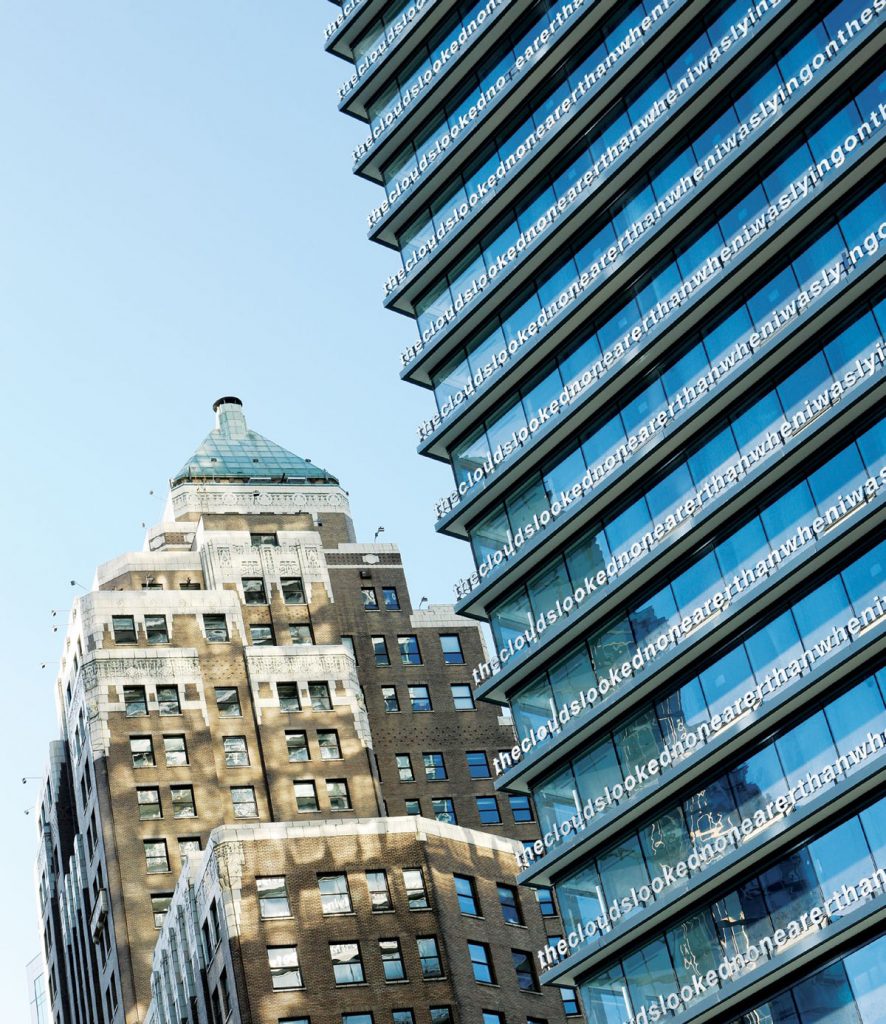
This passage, in the artist’s signature choice of Helvetica bold, occupies floor five through 22 and provides a demarcation between the hotel and the additional 25 floors of luxury residential suites above. The two-foot high letters stand proud on the building’s exterior along narrow concrete fins that sharply turn to accentuate the building’s most public corner. When viewed from the street, the letters reflect the surrounding buildings and shifting colours of the changing Vancouver sky.
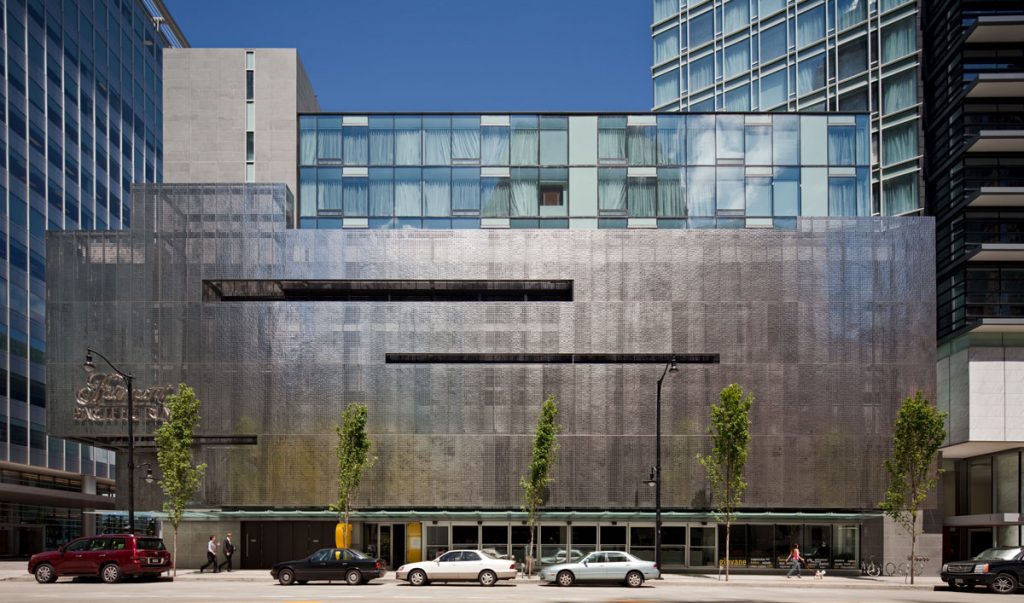
So many things had to come together to pull off the Woodward’s redevelopment and having Stan Douglas produce Abbott & Cordova, 7 August 1971 tied it all together. This work restages the Gastown riot of 1971 and involved more than 100 actors portraying riot police, hippies and Mounted Police. Stan recreated the riot scene by laying down asphalt, reproducing aged building façades and merchandising store windows. The 1971 riot was a pivotal moment in determining Gastown’s current character.
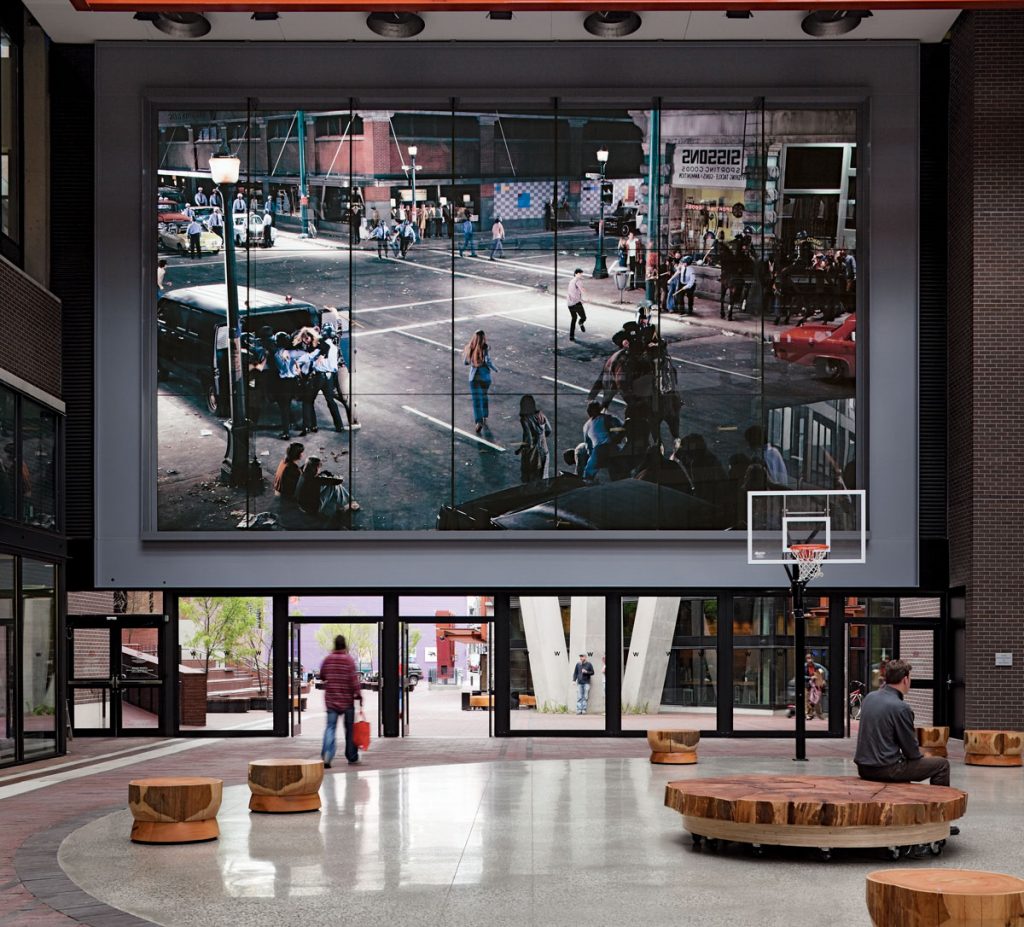
This public art call began with the goal of using the location of the property and the height of the tower to maximum effect. Exploring the use of light to reflect the building’s association to Burrard Inlet and the skyline of Vancouver, Diana Thater’s piece consists of a straight line of dissolving coloured light running from the top of the building to the ground. At grade, the light disperses into a reflective surface while fog generated from the bottom of the building lifts the pool of light up and out, producing a dynamic lightshow. The Shaw sign at the top of the building and the reflective pool at the bottom also create a compositional balance.
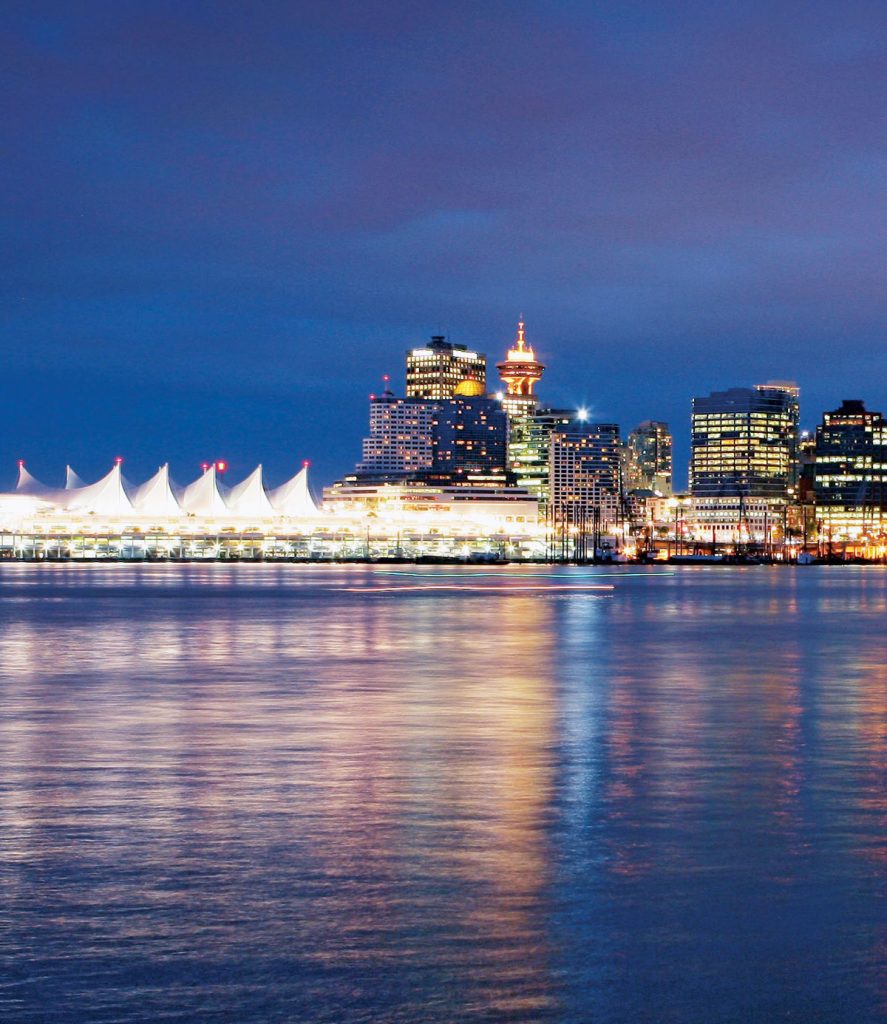
The Dale Chihuly installation was West-bank’s first project with an internationally known artist. Chihuly and his team were very experienced with major installations around the globe, and this delicate, vivid, installation has stood the test of time. While more recent public art installations may express more symbolism, at the time this art made a distinct statement: there is nothing inherently wrong with art being beautiful.
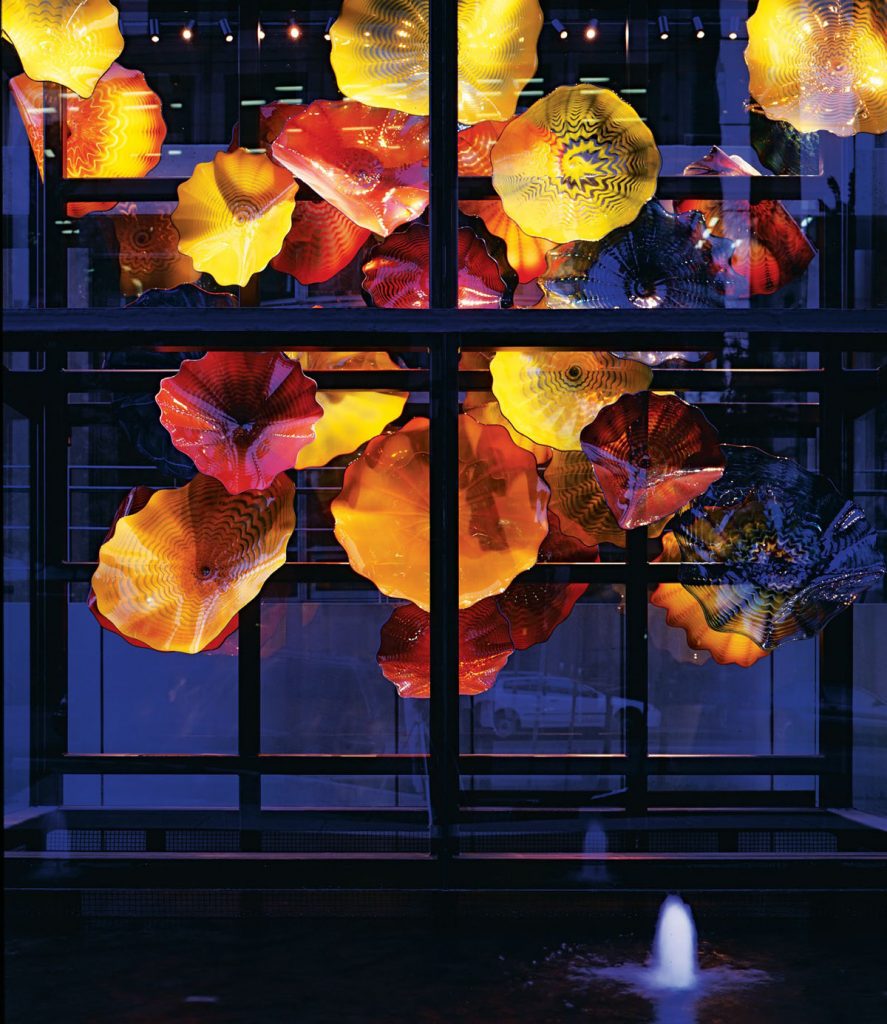
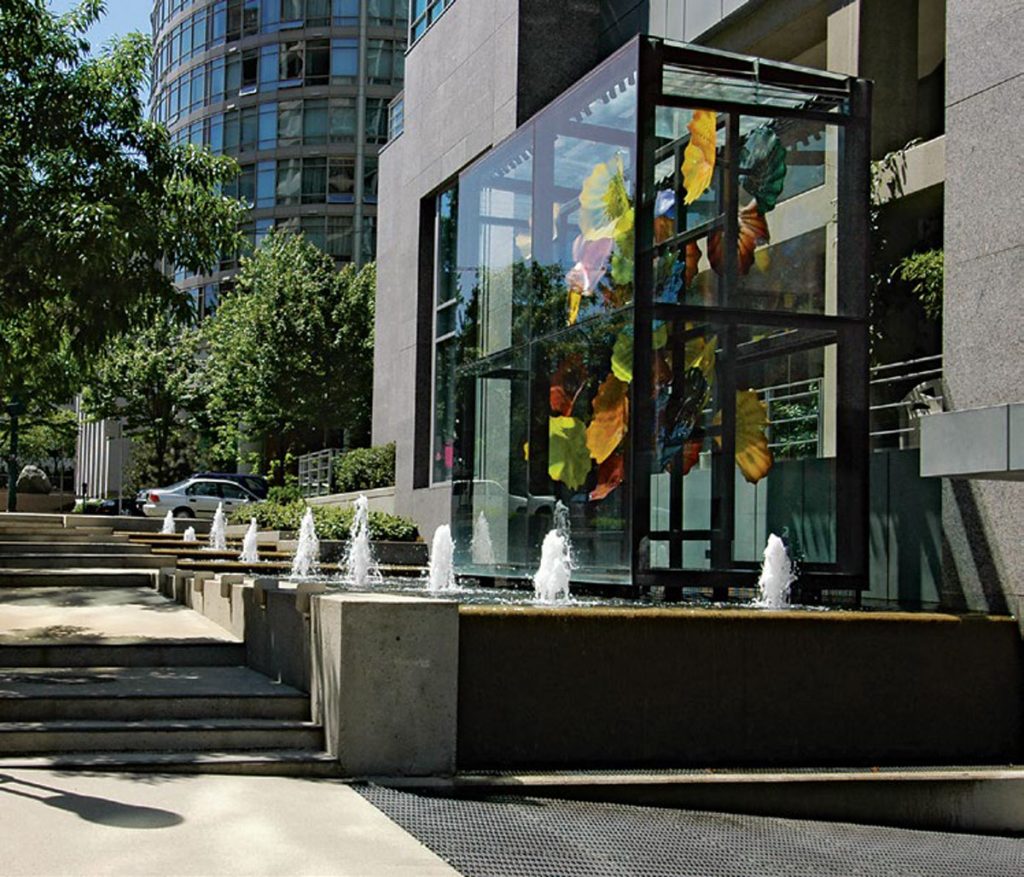

Fight for Beauty Exhibition, September 2017 – February 2018
The core of Westbank’s mission is to create a body of work with a high degree of artistry that helps foster more equitable and beautiful cities. Westbank is active across Canada and in the United States, with projects including residential, hotels, retail, office, rental, district energy, affordable housing and public art.
Established in 1992, Westbank is one of North America’s leading developers, with offices in Vancouver, Toronto, Seattle, Tokyo, Shanghai, Beijing, Taiwan, Hong Kong, Shenzhen and Chengdu, and over 25 billion dollars of projects completed or under development. Westbank is driven by the belief that beauty and culture in all forms and in the broadest definitions, are essential to human existence. In committing their efforts fully towards the fight for beauty and the creation of culture, they have evolved beyond the definition of a traditional real estate development firm, to become a culture company.